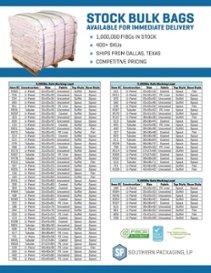Packaging Industry Statistics & Market Overview
The packaging industry is a critical global sector that supports nearly every area of manufacturing and distribution. From food and beverages to..
November 17, 2020
.jpg?width=568&name=unnamed%20(15).jpg)
Polyethylene, Polypropylene, and PVC resins are the building blocks of one of mankind’s most ubiquitous commodities: plastics.
In 2019, U.S. production of resin exceeded 120 billion pounds. This enormous amount of material must flow from the production plant through an extensive supply chain to become the products we utilize each day.
Bulk packaging is a critical component in the resin transportation and converting process. Thermoplastic resin pellets, beads, and powders transition from ethylene cracking plants to co-packing facilities that utilize various forms of industrial packaging including:
Once the resins are packaged, they continue down the supply chain to their end-user where they are converted into versatile plastic products that make life better, healthier, and safer.
.jpg?width=374&name=unnamed%20(16).jpg)
The most common resin produced in the world. PE resin is often used to manufacture plastic packaging and engineered films. Polyethylene is a type of thermoplastic used to manufacture bags, sheeting, stretch film, and shrink film. PE resin generally comes in bead or pellet form. There are several variations of Polyethylene including:
The world’s second most widely produced commodity resin. PP Resin is frequently used to manufacture flexible and rigid plastics including disposable food packaging, medical equipment, FIBC bulk bags and BOPP. PP Resin generally comes in bead or pellet form.
.jpg?width=410&name=unnamed%20(17).jpg)
The world’s third most widely produced commodity resin. PVC resin is used to manufactured flexible and rigid plastics including bottles, cable insulation, flooring, and building products. Today it is used to manufacture much of the construction and utility pipe throughout the world. PVC resin generally comes in a powder form and is more difficult to package than PE and PP.
A coated FIBC is any type of FIBC that is made with standard woven fabric that has been laminated with a PP film layer. The film layer is typically 1.0mil or less and can be applied to the inside or outside of the bag’s fabric. The PP film layer reduces air flow, moisture transmission, and dusting of the contents. The film layer itself does not have any strength properties. Coated FIBCs may also be referred to as laminated or non-breathable bags.
A lined FIBC is a standard circular or U-panel FIBC that has a factory inserted PE liner. FIBC liners are available in 3 basic constructions: Form Fit, Lay Flat, and Baffled. They can be loosely inserted, attached at 8 points using tabs, or glued into the body of the bag. In addition, the liner openings can be cuffed and sewn to the filling and discharge spouts of your bag. Each construction provides enhanced protection against leakage, contamination, and moisture intrusion.
Aluminum Foil, Anti-Static, Conductive, and Food/Pharma Grade liners offer superior protection for highly sensitive products. We offer these unique custom liner solutions for customers requiring the highest degree of product security.
 Need bulk bags for resin now?
Need bulk bags for resin now?Supporting many of the world’s largest resin manufacturers and co-packers requires us to maintain one of the largest inventories of stock resin bags in the United States. Our full complement of 800kg, 1MT, and 1.3MT resin bags are available for immediate shipment to your manufacturing or co-packing facility.
Contact our experienced sales team for more information on our on-demand resin bag inventory.